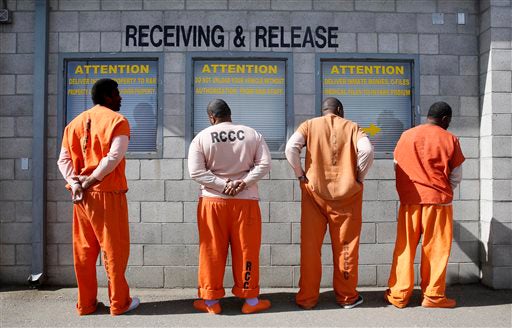|
August 6, 2014
Stanford research suggests support for incarceration mirrors whites' perception of black prison populations
Informing the white public that the percentage of black Americans in prison is far greater than the percentage of white people behind bars may not spur support for reform. Instead, it might actually generate support for the policies – such as stop-and-frisk and three-strikes laws – that created the situation. By Shara Tonn

Stanford psychology researchers discovered that when white voters perceive more black Americans in the prison population, they support harsher laws. (Rich Pedroncelli / Associated Press)
Although African-Americans constitute only 12 percent of America's population, they represent 40 percent of the nation's prison inmates.
But informing the white public of this disproportionate incarceration rate may actually bolster support for the very policies that perpetuate the inequality, according to a study published in Psychological Science, a journal of the Association for Psychological Science.
Stanford psychology researchers Rebecca Hetey and Jennifer Eberhardt found that when white people were told about these racial disparities, they reported being more afraid of crime and more likely to support the kinds of punitive policies that exacerbate the racial disparities.
The expansion of harsh policies – such as California's Three Strikes law and similar measures by other states – has led the United States to have the largest per-capita prison population in the world.
"Most people likely assume this must be due to rising crime rates, but the explosion in the prison population is better explained by harsh criminal justice policies," said Hetey, a postdoctoral scholar and the lead author on the study.
Real-life test
Hetey and Eberhardt, an associate professor of psychology, wanted to know whether making white people aware of racial disparities in incarceration would bolster or diminish their support for draconian policies.
Their first experiment unfolded at a train station near San Francisco. A white female researcher asked 62 white voters to watch a video containing mug shots of male inmates. Some of the participants saw a video in which 25 percent of the mug shots were of black men, while others saw a video in which the percentage of black men among the mug shots rose to 45 percent.
The participants then had an opportunity to sign a real petition aimed at easing the severity of California's three-strikes law. "It seemed like a great opportunity – a real-life political issue – to test this question of whether blacker prison populations lead people to accept these more punitive policies," Eberhardt said.
The results were clear. Over half of the participants who'd seen the mug shots with fewer black men signed the petition, whereas only 27 percent of people who viewed the mug shots containing a higher percentage of black inmates agreed to sign. This was the case regardless of how harsh participants thought the law was.
Stop-and-frisk policy
To determine whether fear of crime might explain these findings, Hetey and Eberhardt conducted a second experiment.
In 2012, the New York City Police Department detained people more than 500,000 times under the city's controversial stop-and-frisk law. Of that total, 55 percent were African-American. For their experiment, Hetey and Eberhardt showed 164 white New Yorkers statistics about the prison population.
The New York residents read about black inmates either in terms of the national incarceration rate (40 percent of prisoners are black) or the New York City rate (60 percent.) Next, they were asked about their support for the stop-and-frisk policy.
About 33 percent of the participants who saw the lower national statistic were willing to sign a petition to end the policy. But only 12 percent of those who saw the higher city rate of black incarceration were willing to sign the petition.
Participants who saw the higher rate of black incarceration were more likely to report concern over crime, which was associated with reluctance to sign the petition.
Social activists or policymakers trying to fight inequality often use statistical evidence to motivate people to join their cause. In light of this study, that strategy may backfire.
"Many legal advocates and social activists seem to assume that bombarding the public with images, statistics and other evidence of racial disparities will motivate people to join the cause and fight inequality," Hetey said. "But we found that, ironically, exposure to extreme racial disparities may make the public less, and not more, responsive to attempts to lessen the severity of policies that help maintain those disparities."
"Our research shows that numbers don't always speak for themselves," Eberhardt said. "Reducing inequality takes more than simply presenting people with evidence of extreme inequality."
Shara Tonn is an intern at the Stanford News Service.
For more Stanford experts on psychology and other topics, visit Stanford Experts.
-30-
|